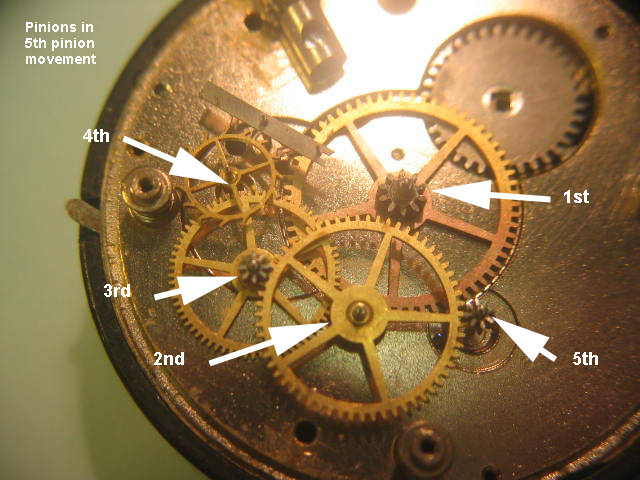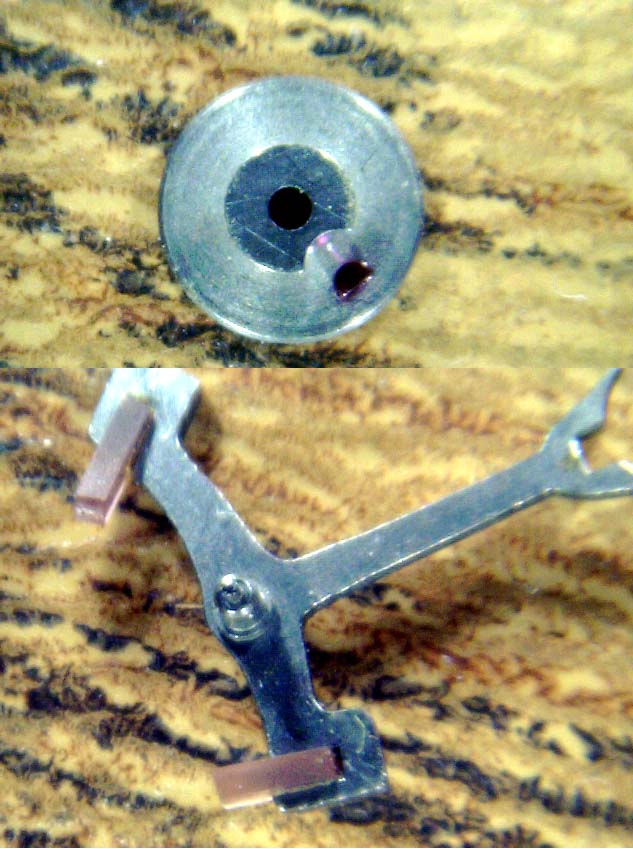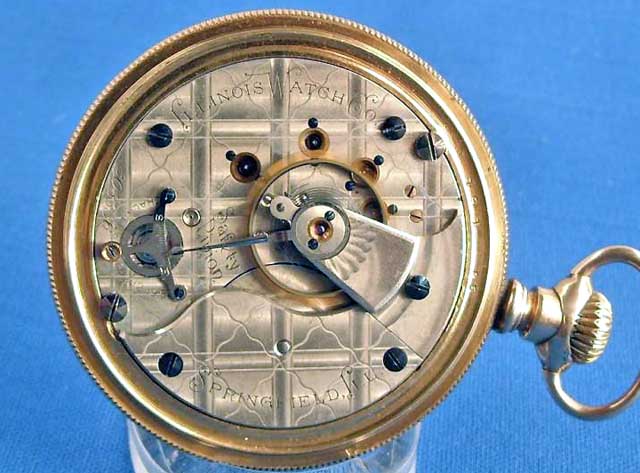
| WWT Shows | CLICK TO: Join and Support Internet Horology Club 185™ | IHC185™ Forums |

|
• Check Out Our... • • TWO Book Offer! • |
Welcome Aboard IHC185™  Internet Horology Club 185
Internet Horology Club 185  IHC185™ Discussion Site Main Page
IHC185™ Discussion Site Main Page  Open to the World RESEARCH FORUMS
Open to the World RESEARCH FORUMS  Illinois Watch Company Research Forum
Illinois Watch Company Research Forum  Information Please
Information Please
 Internet Horology Club 185
Internet Horology Club 185  IHC185™ Discussion Site Main Page
IHC185™ Discussion Site Main Page  Open to the World RESEARCH FORUMS
Open to the World RESEARCH FORUMS  Illinois Watch Company Research Forum
Illinois Watch Company Research Forum  Information Please
Information PleaseGo  | New Topic  | Find-Or-Search  | Notify  | Tools  | Reply to Post  |  |
Here's the face. Unfortunately I don't know the story behind the watch, other than it was in a shadowbox with some other antiques in my Granparent's home for as long as anyone can remember. That's probably why it's in such good shape for it's age. | ||||
Here is the movement. Again, ANY info is appreciated and let me know if you need something else to help you. | ||||
| IHC Life Member Site Moderator |
Hi Matt I am sure the Illinois experts will be with you shortly but in the mean time. Your watch is an 18 size Model 3 with a fifth pinion, if you search the site for fifth pinion you will find discussions about it. Basically it is my understanding that these were the first open face pocket watches made by Illinois & in order to have the second hand at the position it is in on an open face watch the 5th was added for this reason. They later learned how to do it without the 5th pinion. Is yours only key wind or can you also wind it at the stem? Some are transisiton models & can be wound both ways. Looks like a very nice watch. Tom | |||
Hi Matt, The only things I can add: Grade :Courier made : 2,315 between 1879 and 1883 of Runs:18 Jewels: 12 your watch: year 1880 Dial: Sunk Seconds hard enamel Roman numeral Unudjusted-Jewels in settings-Simple regulator I hope it helps | ||||
Thanks for the info. As I said, I know nothing about watches. I hope I don't sound too ignorant. I assume the "stem" is at the top of the watch, and that is how it is wound (the only way that I know of). I don't have a key, nor do I see any way to use a key to wind it. If you unscrew the glass face to access the hands, there is a small lever at about the 2 o'clock position. Can anyone tell me what this does? I can post a photo if that helps. | ||||
| IHC Life Member Site Moderator |
Hi Matt The lever at the 2 o'clock position is how the time is set, by pulling out this lever & then twisting the stem the hands will move to set the time, this is what is known as lever set. You watch is a transistion watch, it is both stem wind & key wound. If you notice on the back of the movement the disc above the words "Springfield" there is a square shaped silver stem in the center. This is where a key would be used to wind the watch. So your watch will wind at the top & can also be wound with a key. Keep asking questions, we all have to start somewhere. Tom | |||
| IHC Life Member |
Matt, I marked your movement picture to help you understand what we mean by the "5th pinion" and the "Key wind arbor". This watch heralded two significant features of Illinois Watches. First it is a transition model which explains why there is both the stem wind and still the Key wind provision on the same movement. Second it shares (with Aurora watch Co.) the exclusive use of a 5th pinion to convert a "Hunter Case" movement which has the winding stem at 3 o'clock to an Open Face movement which has the Stem at 12 o'clock by adding a 5th pinion (gear) to carry the seconds hand at 6 o'clock for the Open Face dial. The idea (we think) was that this only required a slight change of 2 more holes drilled in the movement plus an "extra" 3rd pinion assembled to engage the other side of the 2nd pinion wheel. You will understand this better later. More important, your watch commemorates by name Mr. D.G. Currier who co-designed (with J.K. Bigelow) the Model 1 Illinois movement and patented his improvements under U.S. Patent number 108332. As for Jewelling this has a Jeweled 5th pinion, and I would be very interested to see if that is also jeweled under the dial, thus making it a 12 Jewel movement which would be more collectible (in my opinion). In short, though it is a very nice low serial number Illinois watch worth using and proudly showing off from time to time.  | |||
| IHC Life Member |
Here is the scheme of things "inside" a 5th pinion Illinois movement manufactured very close to when yours was done to help you understand where it all goes  | |||
Thanks again for all of the information. I'm glad you don't mind questions, because I have a ton. What exactly is meant by "jeweled". How can I find out if it is jeweled under the the dial to see if it is a 12 Jewel movement like you said? What is the best way to store my watch, as I don't plan on carrying it. Does it do harm if I don't wind it regularly? Again, sorry for all the questions and thank you for all the help. | ||||
| IHC Life Member Site Moderator |
Matt Here is your photo with the jewels that can be seen marked. The jewels were designed to reduce the amount of friction. So instead of metal to metal the jewel is added so the staff rotates on the jewels.  | |||
| IHC Life Member Site Moderator |
So you see on your watch there are 6 jewels marked, but actually on the balance there are two jewels, this jewel has what is known as a cap jewel covering the jewel that the staff rotates in, if you look closely you will notice the other jewels you can see the hole that the staff fits into but on the balance this jewel is covered by a solid jewel. So this actually makes 7 jewels that can be seen. | |||
| IHC Life Member Site Moderator |
Now inside the watch there should be 3 more jewels that can not be seen. One jewel is located on the balance, this is the roller jewel. This jewel as the balance swings back & forth engages the pallet fork which has two jewels on the opposite end. Due to the rocking action of the balance the jewels on the pallet fork engage & disengage the escape wheel. The photos of these jewels will not look exactly like the parts in your watch but are just for examples.  | |||
| IHC Life Member Site Moderator |
So now with the 7 jewels we can see on your movement we add the 3 jewels from the roller table & pallet fork & we come up with 10 jewels. Now under the dial of your watch there should be 2 more jewels on the opposite side of the balance, again a jewel for the balance staff & then another cap for this jewel. So that brings the total to 12 jewels. | |||
| IHC Life Member Site Moderator |
One last thing, I would not recommend you try to remove the dial. Since you said you had the watch cleaned & it is running & this belonged to your grand parents I would not attempt to take it apart. This is not the kind of watch you want to learn on, if you are interested in working on watches you have come to the right place to learn but the watch you have would not be the one I would start with. Tom | |||
I can assure you, I have NO intentions of trying to take this watch apart!! I am just trying to learn all I can about it. I want to have as much info as possible to get an idea of what it is worth. As I said earlier, I don't know the story behind the watch, so I have no real sentimental attachment to it. Plus I am not a watch collector. If it is worth a decent amount of money and there is someone who could get some enjoyment out of it, I'll probably sell it. If however, it's not that valuable, I won't be disappointed at all, as it did belong to my grandparents and is nearly 130 years old. | ||||
By he way, thanks for all of the info. This stuff is fascinating, and I can see how you all got really hooked on collecting these watches!!! Unfortunately I already have a number of hobbies that take up my time (and of course $$$), so I don't see myself starting a collection of my own. I'll just learn all I can about the one watch I do have. | ||||
| IHC Life Member Site Moderator |
Hi Matt To get an idea of the value, one way is to search on Ebay under the catagory pocket watch for Illinois 18s Model 3, if you check out both current auctions & ones that have already ended you will get an idea of what they are selling for. Unfortuantely quite a few of these watches sell for very little money in my opinion but you also have to remember how many thousands of these were made. It might be worth just hanging onto so you can say you have one. Tom | |||
| IHC Life Member |
I add below a cost study of these movements that might help you see what the "eBay" price range is for these. In your case with the chipped Crystal, it has to be around $100.00 max. If you keep it, the "heirloom" value of this will grow considerably as it is unique for the reasons I listed earlier in this thread. s/n - age - grade - notes - size - # jewels 242140 1878 Gr 101 Ni Dmk mdl 3 18 11 $ 52.00 296107 1879 Gr 99 Chlmrs Reg 18 11 $ 56.00 2766058 1915 Riggs & Bro private label 18 11 $ 66.00 331859 1883 "Currier" 5th Pinion Mvt. 18 13 $ 83.00 1228781 1895 Gilded mvt "DPL" Engr. 18 11 $ 86.00 1257354 1896 2-sg'd"The National Chicago" 18 11 $ 86.00 701891 1887 "Locomotive" Eng on Mvt. 18 11 $ 94.00 330146 1880 "Currier" Coin Si Case 18 13 $ 102.00 331171 1880 "Currier" Coin Si Case 18 13 $ 103.00 34456 1873 Very Early Mdl 1 18 11 $ 122.00 242839 1878 OF K/SW/LS transition 18 13 $ 128.00 5089 1872 "Currier" tripl sig'd SWC 18 13 $ 135.00 204025 1877 Gr 101 Ni Dmk mdl 3 18 11 $ 147.00 351139 1881 Forest City RARE! 18 11 $ 148.00 | |||
I've been searching all over the internet and have come to the same conclusion....it's not worth enough to sell. I'll hang on to it. Just wish I knew the story behind it. Since I am keeping it, can you give me advice on the best way to store it? Also, does it harm the watch if I don't wind it frequently? | ||||
| IHC Life Member |
Matt, storage is simply a dry place with the mainspring unwound if possible. So if it is running, let it run down. You might like to keep with it a printout of our comments. | |||
| IHC Member 1101 Site Moderator |
Here is another example of the 5th pinion, this one is for sale. It is described as "18-size, Grade 100 with 15-Jewels, Chalmers Regulator, made in 1881" and $129.95 is the Buy-It-Now price. Steve 5th Pinion  | |||
Thank you all very much for the information, I really appreciate it. I just have one last question. I'm not sure if you can know without seeing the watch, but any guess as to what it is made of? It seems pretty heavy. Thanks again for all of your help. | ||||
| IHC Member 1101 Site Moderator |
Matt, Are there any markings on the inside of the case back? A photo here may be of help as well. Steve | |||
There are some markings, but it'd probably be easier to show you than expain them. I'll post a photo when I can. | ||||
Here is the marking inside the case back. | ||||
| IHC Member 1101 Site Moderator |
Matt, I could be wrong here but I am thinking that siverode is the same as what gold filled would be but done with silver. I am sure if I am wrong here someone will jump in and correct me. Steve | |||
| IHC Life Member |
It is my understanding that Silverode and similar cases are made mainly from nickel and do not have any silver in them. They usually are heavy and very durable. | |||
Thanks for the info, it is defintely heavy and seems durable so that is probably correct. I have one last question (I think this is the last). Most watches I have seen have the back and/or front open on a hinge. On my watch, both of them have to be un-screwed. Any reason for this, or is this just how my particular model was made? | ||||
| IHC Life Member |
Durability. As evidenced by the ratio of "surviving" cases being 2 - 1 "screw cover and crystal bezel" One exception are "swing" cases which only had a screw on bezel and a "trap-door" movement ring. They were very very popular among Locomotive Engineers as they had the disposition (and "heft")of a Sherman Tank!  | |||
| Powered by Social Strata |
| Your request is being processed... |
|
©2002-2025 Internet Horology Club 185™ - Lindell V. Riddle President - All Rights Reserved Worldwide

